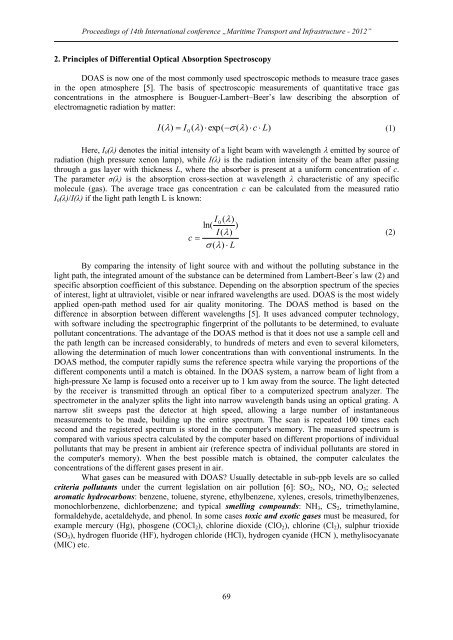14. starptautiskÄ konference 2012 - Latvijas JÅ«ras akadÄmija
14. starptautiskÄ konference 2012 - Latvijas JÅ«ras akadÄmija
14. starptautiskÄ konference 2012 - Latvijas JÅ«ras akadÄmija
You also want an ePaper? Increase the reach of your titles
YUMPU automatically turns print PDFs into web optimized ePapers that Google loves.
Proceedings of 14th International conference „Maritime Transport and Infrastructure - <strong>2012</strong>”2. Principles of Differential Optical Absorption SpectroscopyDOAS is now one of the most commonly used spectroscopic methods to measure trace gasesin the open atmosphere [5]. The basis of spectroscopic measurements of quantitative trace gasconcentrations in the atmosphere is Bouguer-Lambert–Beer’s law describing the absorption ofelectromagnetic radiation by matter:I( ) I0()exp(( )c L)(1)Here, I 0 (λ) denotes the initial intensity of a light beam with wavelength emitted by source ofradiation (high pressure xenon lamp), while I(λ) is the radiation intensity of the beam after passingthrough a gas layer with thickness L, where the absorber is present at a uniform concentration of c.The parameter σ(λ) is the absorption cross-section at wavelength λ characteristic of any specificmolecule (gas). The average trace gas concentration c can be calculated from the measured ratioI 0 (λ)/I(λ) if the light path length L is known:I ( )ln( 0 )I()c ( ) L(2)By comparing the intensity of light source with and without the polluting substance in thelight path, the integrated amount of the substance can be determined from Lambert-Beer`s law (2) andspecific absorption coefficient of this substance. Depending on the absorption spectrum of the speciesof interest, light at ultraviolet, visible or near infrared wavelengths are used. DOAS is the most widelyapplied open-path method used for air quality monitoring. The DOAS method is based on thedifference in absorption between different wavelengths [5]. It uses advanced computer technology,with software including the spectrographic fingerprint of the pollutants to be determined, to evaluatepollutant concentrations. The advantage of the DOAS method is that it does not use a sample cell andthe path length can be increased considerably, to hundreds of meters and even to several kilometers,allowing the determination of much lower concentrations than with conventional instruments. In theDOAS method, the computer rapidly sums the reference spectra while varying the proportions of thedifferent components until a match is obtained. In the DOAS system, a narrow beam of light from ahigh-pressure Xe lamp is focused onto a receiver up to 1 km away from the source. The light detectedby the receiver is transmitted through an optical fiber to a computerized spectrum analyzer. Thespectrometer in the analyzer splits the light into narrow wavelength bands using an optical grating. Anarrow slit sweeps past the detector at high speed, allowing a large number of instantaneousmeasurements to be made, building up the entire spectrum. The scan is repeated 100 times eachsecond and the registered spectrum is stored in the computer's memory. The measured spectrum iscompared with various spectra calculated by the computer based on different proportions of individualpollutants that may be present in ambient air (reference spectra of individual pollutants are stored inthe computer's memory). When the best possible match is obtained, the computer calculates theconcentrations of the different gases present in air.What gases can be measured with DOAS? Usually detectable in sub-ppb levels are so calledcriteria pollutants under the current legislation on air pollution [6]: SO 2 , NO 2 , NO, O 3 ; selectedaromatic hydrocarbons: benzene, toluene, styrene, ethylbenzene, xylenes, cresols, trimethylbenzenes,monochlorbenzene, dichlorbenzene; and typical smelling compounds: NH 3 , CS 2 , trimethylamine,formaldehyde, acetaldehyde, and phenol. In some cases toxic and exotic gases must be measured, forexample mercury (Hg), phosgene (COCl 2 ), chlorine dioxide (ClO 2 ), chlorine (Cl 2 ), sulphur trioxide(SO 3 ), hydrogen fluoride (HF), hydrogen chloride (HCl), hydrogen cyanide (HCN ), methylisocyanate(MIC) etc.69
















